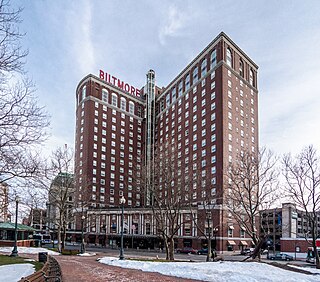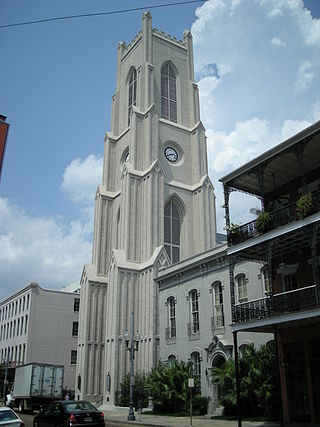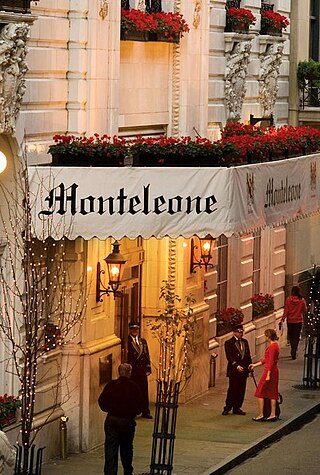
The French Quarter, also known as the Vieux Carré, is the oldest neighborhood in the city of New Orleans. After New Orleans was founded in 1718 by Jean-Baptiste Le Moyne de Bienville, the city developed around the Vieux Carré, a central square. The district is more commonly called the French Quarter today, or simply "The Quarter", related to changes in the city with American immigration after the 1803 Louisiana Purchase. Most of the extant historic buildings were constructed either in the late 18th century, during the city's period of Spanish rule, or were built during the first half of the 19th century, after U.S. purchase and statehood.

Rex is a New Orleans Carnival Krewe which stages one of the city's most celebrated parades on Mardi Gras Day. Rex is Latin for "King", and Rex reigns as "The King of Carnival".

Saint Louis Cemetery is the name of three Catholic cemeteries in New Orleans, Louisiana. Most of the graves are above-ground vaults constructed in the 18th and 19th centuries.

The Faubourg Marigny is a neighborhood of the city of New Orleans, Louisiana, United States.

The Graduate Providence is an upscale hotel that opened in 1922 as the Providence Biltmore Hotel, part of the Bowman-Biltmore Hotels chain. It is located on the southern corner of Kennedy Plaza at 11 Dorrance Street in downtown Providence, Rhode Island. It was added to the National Register of Historic Places in 1977 and is a member of Historic Hotels of America, the official program of the National Trust for Historic Preservation.

Broadmoor is a neighborhood of the city of New Orleans. A subdistrict of the Uptown/Carrollton Area, its boundaries as defined by the New Orleans City Planning Commission are: Eve Street to the north, Washington Avenue and Toledano Street to the east, South Claiborne Avenue to the south, and Jefferson Avenue, South Rocheblave Street, Nashville Avenue, and Octavia Street to the west. It includes the Broadmoor Historic District which was listed on the National Register of Historic Places in 2003 and increased in its boundaries in 2007.

The 5th Ward or Fifth Ward is a division of the city of New Orleans, Louisiana, one of the 17 Wards of New Orleans.

Rampart Street is a historic avenue located in New Orleans, Louisiana.
Royal Street is a street in the French Quarter of New Orleans, Louisiana, U.S. It is one of the original streets of the city, dating from the early 18th century, and is known today for its antique shops, art galleries, and hotels.

The Roosevelt New Orleans in New Orleans, Louisiana, is a 504-room hotel owned by AVR Realty Company and Dimension Development and managed by Waldorf Astoria Hotels & Resorts. The hotel was originally built by Louis Grunewald, a German immigrant, and opened in 1893 as "The Hotel Grunewald."

St. Charles Avenue is a thoroughfare in New Orleans, Louisiana, U.S. and the route of the St. Charles Streetcar Line. It is also famous for the dozens of mansions that adorn the tree-lined boulevard for much of the uptown section of the boulevard. It is named for St. Charles Borromeo, patron saint of Charles III of Spain, the monarch when France transferred the then-vast territory of Louisiana to Spain at the conclusion of the Seven Years' War in 1763.

St. Patrick's Church is a Catholic church and parish in the Archdiocese of New Orleans, Louisiana, United States. The parish was founded in 1833, and the current structure was completed in 1840. It is the second-oldest parish in New Orleans, located upriver from the French Quarter at 724 Camp Street in what is now the Central Business District. The building, a National Historic Landmark, is one of the nation's earliest and finest examples of Gothic Revival architecture.

The buildings and architecture of New Orleans reflect its history and multicultural heritage, from Creole cottages to historic mansions on St. Charles Avenue, from the balconies of the French Quarter to an Egyptian Revival U.S. Customs building and a rare example of a Moorish revival church.

St. Augustine Church is a Catholic parish in New Orleans. Established by free people of color, who also bought pews for slaves, it is said to be the oldest Black Catholic parish in the United States, established in 1841. It was one of the first 26 sites designated on the state's Louisiana African American Heritage Trail.
The Windsor Court Hotel is a luxury hotel in the Central Business District of New Orleans, Louisiana. The building rises 253 feet. It contains 23 floors, and was completed in 1984. In 2011, Travel + Leisure magazine ranked the Windsor Court as the 6th Best Large City Hotel in the United States and Canada. Windsor Court Hotel currently stands as the 37th-tallest building in the city, and the 10th-tallest hotel. The building is an example of modern architecture.

Hotel Monteleone is a family-owned and operated hotel located at 214 Royal Street in the French Quarter of New Orleans, Louisiana, U.S. The hotel includes the only high-rise building in the interior French Quarter and is well known for its Carousel Piano Bar & Lounge, a rotating bar.

In 1870, the Louisville and Nashville Railroad was constructed through the southernmost section of Harrison County, Mississippi, connecting New Orleans, Louisiana, and Mobile, Alabama. A northern transportation route into south Mississippi was provided by the Gulf and Ship Island Railroad at the turn of the 20th century. These railroads provided an inexpensive means for moving passengers as well as goods, and opened south Mississippi to both industrial and recreational development. Rapidly progressing lumber and seafood industries transformed the Mississippi Gulf Coast in the 1920s, and people arrived from throughout the United States to take advantage of the economic boom. Northern tourists were attracted to the Mississippi Gulf Coast because of mild winters and cool sea breezes in summer, before the introduction of air conditioning. Besides the weather, other tourist attractions included seafood restaurants, swimming, golf, schooner races, sailing to offshore islands, and recreational fishing. During this period of economic expansion, grand hotels were constructed along the Mississippi Gulf Coast to accommodate businessmen, tourists, and transient workers. Most of these grand hotels no longer exist; and of the two structures that were still standing after the first decade of the 21st century, neither served as a lodging establishment. Together, these grand hotels represented an important era in the history of the Mississippi Gulf Coast throughout the 20th century.

The St. Louis Hotel was built in 1838 at the corner of St. Louis and Chartres Street in New Orleans, Louisiana, United States. Originally it was referred to as the City Exchange Hotel.

The Historic Cemeteries of New Orleans, New Orleans, United States, are a group of forty-two cemeteries that are historically and culturally significant. These are distinct from most cemeteries commonly located in the United States in that they are an amalgam of the French, Spanish, and Caribbean historical influences on the city of New Orleans in addition to limitations resulting from the city's high water table. The cemeteries reflect the ethnic, religious, and socio-economic heritages of the city. Architecturally, they are predominantly above ground tombs, family tombs, civic association tombs, and wall vaults, often in neo-classical design and laid out in regular patterns similar to city streets. They are at times referred to colloquially as “Cities of the Dead”, and some of the historic cemeteries are tourist destinations.

Historic Hotels of America is a program of the National Trust for Historic Preservation that was founded in 1989 with 32 charter members; the program accepts nominations and identifies hotels that have maintained their authenticity, sense of place, and architectural integrity. In 2015, the program included over 260 members in 44 states, including the District of Columbia, Puerto Rico, and the U.S. Virgin Islands. In 2022, the program includes 273 hotels. This article lists current and former member hotels.



















